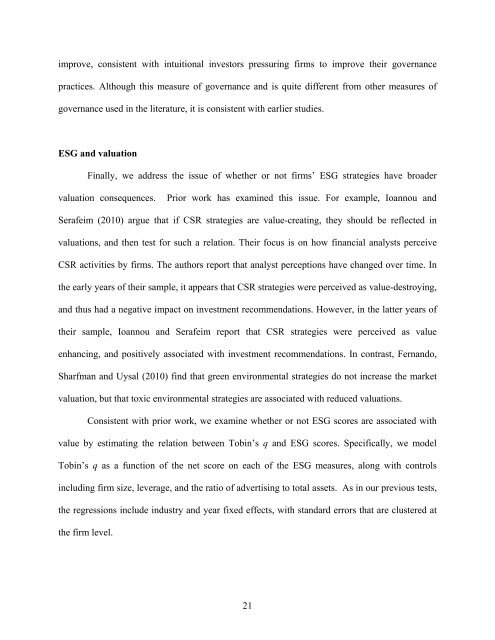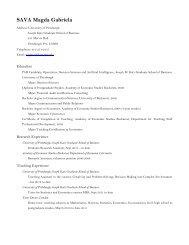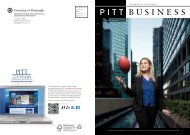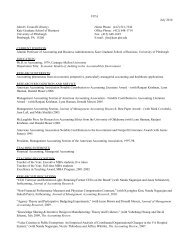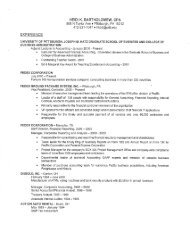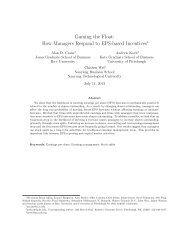Stuart L. Gillan, Jay C. Hartzell, Andrew Koch, and ... - Pitt Business
Stuart L. Gillan, Jay C. Hartzell, Andrew Koch, and ... - Pitt Business
Stuart L. Gillan, Jay C. Hartzell, Andrew Koch, and ... - Pitt Business
You also want an ePaper? Increase the reach of your titles
YUMPU automatically turns print PDFs into web optimized ePapers that Google loves.
improve, consistent with intuitional investors pressuring firms to improve their governance<br />
practices. Although this measure of governance <strong>and</strong> is quite different from other measures of<br />
governance used in the literature, it is consistent with earlier studies.<br />
ESG <strong>and</strong> valuation<br />
Finally, we address the issue of whether or not firms’ ESG strategies have broader<br />
valuation consequences. Prior work has examined this issue. For example, Ioannou <strong>and</strong><br />
Serafeim (2010) argue that if CSR strategies are value-creating, they should be reflected in<br />
valuations, <strong>and</strong> then test for such a relation. Their focus is on how financial analysts perceive<br />
CSR activities by firms. The authors report that analyst perceptions have changed over time. In<br />
the early years of their sample, it appears that CSR strategies were perceived as value-destroying,<br />
<strong>and</strong> thus had a negative impact on investment recommendations. However, in the latter years of<br />
their sample, Ioannou <strong>and</strong> Serafeim report that CSR strategies were perceived as value<br />
enhancing, <strong>and</strong> positively associated with investment recommendations. In contrast, Fern<strong>and</strong>o,<br />
Sharfman <strong>and</strong> Uysal (2010) find that green environmental strategies do not increase the market<br />
valuation, but that toxic environmental strategies are associated with reduced valuations.<br />
Consistent with prior work, we examine whether or not ESG scores are associated with<br />
value by estimating the relation between Tobin’s q <strong>and</strong> ESG scores. Specifically, we model<br />
Tobin’s q as a function of the net score on each of the ESG measures, along with controls<br />
including firm size, leverage, <strong>and</strong> the ratio of advertising to total assets. As in our previous tests,<br />
the regressions include industry <strong>and</strong> year fixed effects, with st<strong>and</strong>ard errors that are clustered at<br />
the firm level.<br />
21


